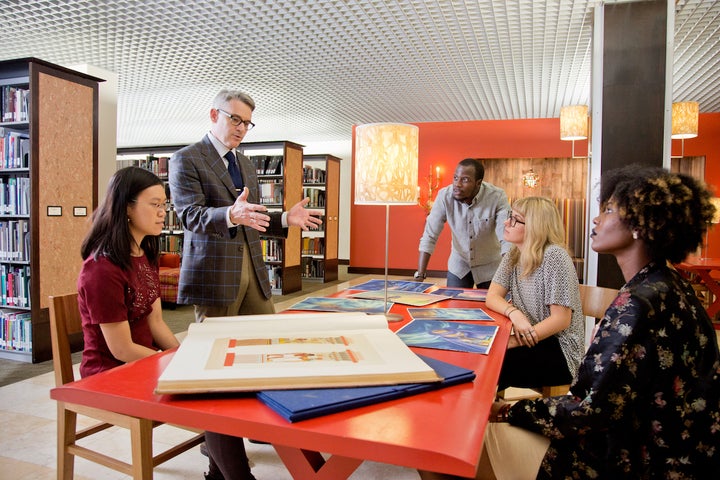
In higher education, people like to pick sides and stay there, often in the face of stubborn facts. Such is true of the ongoing and seemingly endless debate in higher education of vocational preparation vs. liberal education.
On the one hand, many parents and—increasingly—millennials and members of Generation Z are calling for career-specific education. On the other hand, cultural icons and thinkers, from the late Steve Jobs to CNN's Fareed Zakaria, have insisted that the way forward is through classical liberal learning, where students consider the most enduring questions of the human condition through the study of literature, the arts, and the social sciences.
And yet, who says today's universities must focus on one or the other? To forsake considerations of the practical is foolhardy, whereas to ignore the deepest longing of the human heart is just as shortsighted. I am privileged to serve as president of a university that champions a third way.
When I helped create the Savannah College of Art and Design (SCAD) in 1978, I saw that most art and design colleges simply ignored the question of careers. In art college catalogs of the day, one hardly found mention of career services, and so I set out to change that. Nearly 40 years and tens of thousands of gainfully employed alumni later, I'm happy to say that we've been a success. Marrying the sublime and the practical into one unified, balanced learning experience isn't easy, nor is it unique to specialized institutions such as ours. I believe that other universities can achieve similar results, especially if they consider three imperatives.
First, universities must adapt. Moss should not gather on a college catalog. The strength and evolution of the curriculum are supremely important as universities ensure their students are prepared for careers. Faculty and academic administrators do themselves a credit to seek input from three sources when revising a program's curriculum: the discipline (What trends in research should the curriculum reflect?), the students (Where does enrollment data indicate increased student interest, and how can curriculum evolve to reflect that?), and the professions that hire graduates (What qualities do employers need in their new hires?).
As sacrilegious as that latter question may sound to some, universities benefit from inviting professionals outside the academy into our departments to help us understand how best to prepare students to flourish in the workplace. Long ago, business and law schools figured this out, creating advisory boards to help ensure their curricula continued to make sense for those evolving professions. And so why not organize an advisory board for an English or history department, consisting of working professionals in those areas—archivists, writers, journalists, critics, analysts, for example—who can help close the often too-great distance between where the curriculum takes the students and where graduates are expected to land?
Creating and teaching new or significantly revised courses is no small task. But it does our students a disservice to ignore new discoveries and trends for the sake of nostalgia. Universities must revisit their existing degree programs and seek ways to update curricula to adjust to changing professions. It's backbreaking work, but no work is more important.
Second, universities should marry the intellectual and the practical in the same classroom. It's one thing to create a curriculum designed to address the intellectual and the practical, but why not address both in the very same course? To best prepare students for life after commencement, students need to work directly on real-world projects—with real-world partners (e.g., a local nonprofit, a school district, an established business). Universities benefit themselves and their students by welcoming external clients into select for-credit courses, placing students in immersive interactions that reflect a true working environment and offer real-world experience at a time when they need it most.
Not long ago in the Harvard Business Review, Michael D. King suggested that collaboration among universities and industry partners isn't merely useful for students, but that it can engender significant curricular improvements. The invaluable experience of working alongside leading companies opens the minds of students to the praxis of successful employment and the dedication required to thrive at the next level, while also inviting students to apply the broader lessons of liberal education to specific real-world challenges.
Third, universities in their perpetuity keep the dream alive. If universities exist, in part, to nurture the grandest hopes and dreams of their future graduates, then academic leaders should find ways to continue serving those graduates after commencement. Too often, alumni are viewed as donor prospects, classified by total giving capacity. More than ever, universities are bombarding alumni with ask after ask, especially younger alumni. Perhaps universities should consider offering graduates more than just an upturned palm. What if we continued to serve alumni the same way we serve students, with intentionality toward developing both their employability and the fulfillment of their dreams?
Students and parents should choose universities who court their alumni like prospective students — who, years after graduating, continue to coach them in choosing new careers, to counsel them on prospective opportunities, and to assist them in learning new skills as their chosen careers continue to evolve.
I am heartened to see more and more universities embracing the marriage of the practical and the intellectual, for the grandest aspirations of students should be amplified when they enroll in college, as they progress through their programs of study, and again when they graduate.
